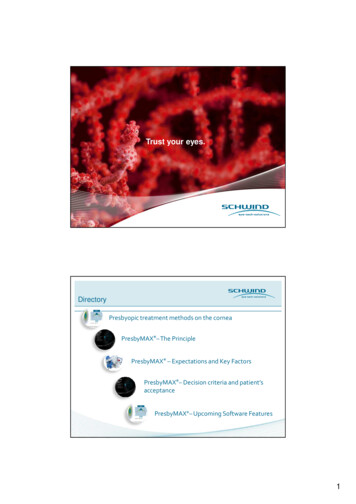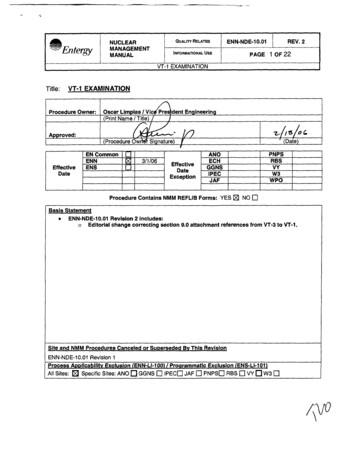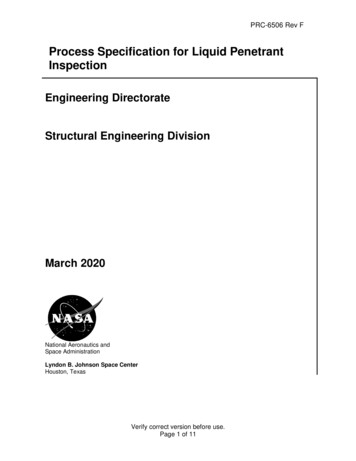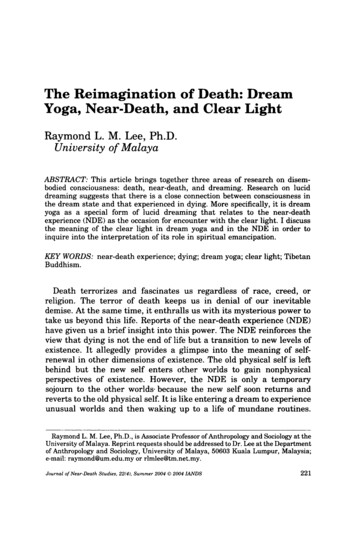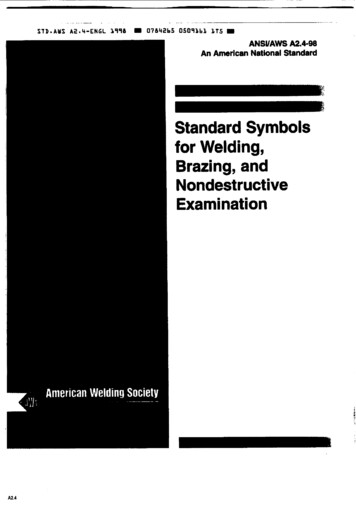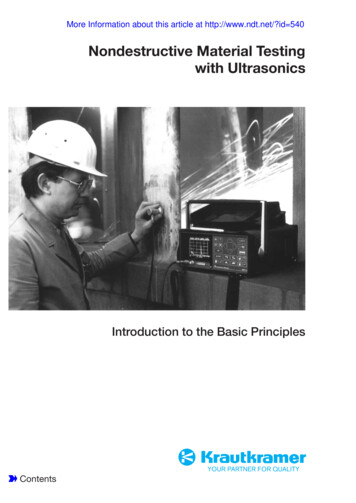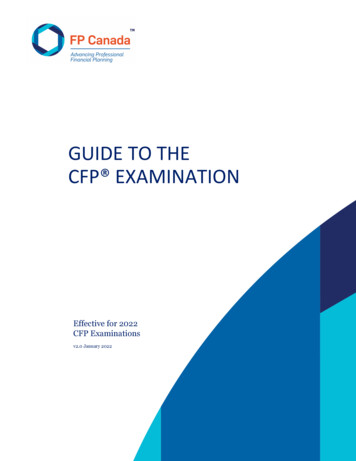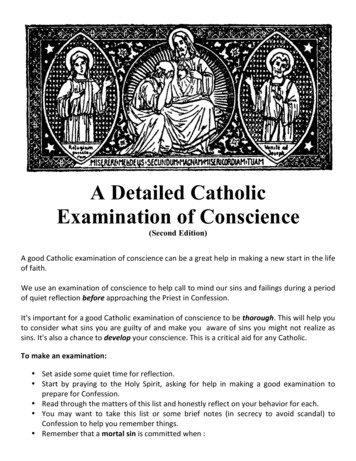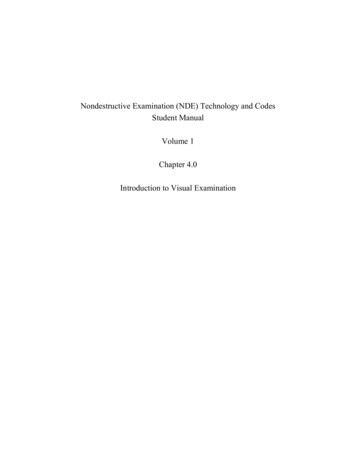
Transcription
Nondestructive Examination (NDE) Technology and CodesStudent ManualVolume 1Chapter 4.0Introduction to Visual Examination
NDE Technology and Codes Student ManualTable of ContentsTABLE OF CONTENTS4.0 INTRODUCTION TO VISUAL EXAMINATION. 1Learning Objectives4.1 History. 14.2 Personnel Qualification and Certification . 14.2.1Visual Acuity . 24.2.2Equipment .24.2.3 Experience and Training . 24.2.4 --------------------------------------34.2.5. 3Certification4.3 Principles of Visual Testing . 44.3.1Applications. 44.3.2 Visual Factors .54.3.3Human Eye . 54.3.3.1 Refractivity . 64.3.3.2 Distance Judgment . 64.3.3.3 Mechanism of Vision. 74.3.3.4 Light Receptors. 74.3.4Color and Color Vision. 74.3.4.1 Color Characteristics . 74.3.4.2 Brightness Characteristics . 84.3.4.3 Spectrum Limits of Visibility . 84.3.4.4 Color Changes . 8USNRC Technical Training Center4 iRev 0409
NDE Technology and Codes Student ManualTable of Contents4.3.5 Observer Differences . 94.3.6Lighting. 94.3.7 Specific Lighting Devices . 104.4 Imaging Equipment4.4.1 Mirrors. 10. 104.4.2 Magnification . 104.4.2.1 Focal Length . 114.4.2.2 Magnifying Devices . 114.4.3 Borescopes and Fiberscopes . 124.4.3.1 Borescopes . 124.4.3.2 Fiberscopes . 134.4.4 Electronic Imaging . 134.4.4.1 Closed Circuit Television . 134.4.4.2 Cathode-ray Tube (Viewing) . 134.4.4.3 Digital Imaging . 144.4.5 Photographic Techniques . 154.4.5.1 Depth of Field . 154.4.5.2 Lighting . 164.4.5.3 Film . 164.5 Measuring Equipment .164.5.1 Linear Scales . 164.5.2Steel Rules. 174.5.3 The Vernier Scale . 174.5.4 Vernier Calipers . 17USNRC Technical Training Center4 iiRev 0409
NDE Technology and Codes Student Manual4.5.5Table of ContentsDial Calipers . 184.5.6 Micrometer. 184.5.7 Micrometer Depth Gages. 184.5.8 Dial Indicator . 184.5.9 Balanced Dials . 184.5.10 Combination Square Set . 194.5.11 Thread Pitch Gages . 194.5.12 Thickness Gages . 194.5.13 Levels. 194.6 Visual Examination of Welds . 194.6.1Prior to Welding . 194.6.2During Welding . 204.6.3 After Welding. . . . . . . . . . . . . . . . . . . . . . . . . . . . . . . . . . . . . . . . . . . . . . . . . . . 204.6.4Weld Examination Gages . 204.6.4.1 Fillet Weld Gage . 204.6.4.2 Multipurpose Gage . 214.6.4.3 Taper Gage . 214.6.4.4 Hi-Lo Gage . 214.6.4.5 Ferrite Gages. 214.7 Remote Visual Inspection (RVI) . 214.7.1 Fiber-optic Borescopes, Fiberscopes, and Video image scopes . 214.7.2Liquid Penetrant Examinations Combined with RVI . 22USNRC Technical Training Center4 iiiRev 0409
NDE Technology and Codes Student ManualTable of Contents4.7.3 Magnetic Particle Examinations Combined with RVI . 234.7.4Ultrasonic Examinations Combined with RVI . 234.7.5Eddy Current Examinations Combined with RVI . 234.8 Specific Applications for Power Generation . 244.8.1Steam Turbines . 244.8.2 Surface Condensers and Heat Exchangers . 244.9 Visual Examination Code Requirements . 254.9.1ASME-Section V . 254.9.2ASME-Section XI. 254.9.2.1 Supplemental Qualifications ofVT Examination Personnel. 274.9.3AWS Certified Welding Inspector . 264.10Records. 274.11Advantages and Limitations of Visual Testing . 274.11.1 Advantages. 274.11.2 Limitations. 28LIST OF TABLES4-1 Precision, Accuracy, and Reliability . 29USNRC Technical Training Center4 ivRev 0409
NDE Technology and Codes Student ManualTable of ContentsLIST OF FIGURES4-1 Electromagnetic Spectrum . 304-2 Direction of View (DOV) . 314-3 Typical Borescope . 324-4 Fiberscope .334-5 Halitation .344-6 Vernier Caliper . 354-7 Dial Indicating Calipers . 364-8 Micrometer . 374-9 Dial Indicator . 384-10 Combination Square Set . 394-11 Thread Pitch Gages . 404-12 Measuring Convex Fillet Weld Size. 414-13 Measuring Concave Fillet Weld Size . 424-14 Palmgren Weld Gage . 434-15 Weld Gages. 44USNRC Technical Training Center4 vRev 0409
NDE Technology and CodesStudent ManualChapter 4.0 Introduction toVisual Examinationor destroying the object being examined.”4.0 INTRODUCTION TO VISUAL EXAMINATIONLearning Objectives:To enable the student to:1. Understand the basic concepts and use ofVisual Examination (VT) and the qualification/ certification of examiners.2. Become familiar with general applications ofVT.3. Recognize the equipment used for VT.4. Understand the processes and techniques bywhich VT is applied to the examination ofmaterials, components, and structures.5. Know the importance of the qualification andcertification of personnel in VT.6. Recognize the advantages and limitations ofVT.4.1 HistoryThe oldest and most commonly used NDEmethod is Visual Examination (VT). It mayalso be the least understood and least effectivelyused of all methods. There is a differencebetween just looking at an object and reallyseeing it through a trained eye. VT may bedefined as ‘an examination of an object using thenaked eye, alone or in conjunction with variousmagnifying devices, without changing, altering,USNRC Technical Training CenterIn VT the most important tools are the eyes.Visual acuity is of prime importance to the visualexaminer. According to recent statistics, at least50 percent of the American population overtwenty years of age is required to wear some typeof corrective lenses. However, in the earlystages of eyesight failure, either many personsare not aware that they need corrective lenses orthey just do not wear them.As with any sensitive tool, the mostimportant tools in VT must be checked foraccuracy at regular intervals to ensure that theyremain accurate and sensitive. Most codesrequire that VT examiners have annual eye teststo check: Near vision acuity, Far vision acuity, and Color perception.Although the eyes are the most importanttool, in many situations they are not sensitiveenough, not accurate enough, or cannot get to thearea to be examined. In those cases, the use ofoptical aids is necessary in order to complete thevisual examination.4.2 Personnel Qualification and CertificationThe training and qualification requirementsfor VT were debated vigorously over many yearswithin the NDE community. Many argued thatSNT-TC-1A should not include VT, feeling itwas not necessary and was being pushed on4 1Rev 0409
NDE Technology and CodesStudent Manualindustry by the utilities.However, theproponents of VT as an NDE Method prevailed,and the recommendation for training andexperience were added to the 1988 edition ofSNT-TC-1A. Prior to 1988, and still withinmany companies today, alternate programs areused. In addition, the Electric Power ResearchInstitute’s (EPRI) NDE Center developed extensive training programs to meet the VT examination requirements of ASME Section XI forIn-service Examination of Nuclear Power Plants.Outside the power industry, the need forexperienced, well-trained weld examiners wasrecognized. In the late 1970's, the AmericanWelding Society developed its Certified WeldingInspector (CWI) program to meet this need.Section 4.9.3 provides a brief overview for thisprogram.4.2.1Visual AcuityOne of the more obvious prerequisites is thatthe VT examiner should have sufficient visualacuity to perform an adequate examination.Consideration should be given to sufficient nearand far vision with natural or corrected vision.A documented periodic eye test is a requirementof many codes and specifications and isgenerally considered good practice. An eye testby a qualified examiner is a prerequisite forcertification by AWS as a CWI or a CertifiedAssociate Welding Inspector (CAWI). Visiontests are also required by ASME Sections V andXI for VT Examiners.USNRC Technical Training CenterChapter 4.0 Introduction toVisual Examination4.2.2EquipmentA VT that requires the use of special tools orequipment will depend upon the application andpossibly the degree of accuracy required for theexamination. Some tools may need specialqualifications prior to use, as in the example ofcalibrations. Although this presents an outlineof VT examination aids, there are many differentconcepts and other variations of equipment. Asa general rule, those tools which comply with aparticular code and specification, adequate formeasuring to the accuracy of the acceptancecriteria, or which satisfy the need of the examination, should be used.4.2.3Experience and TrainingAnother obvious prerequisite is that the VTexaminer should have sufficient knowledge andskill to perform the examination successfully andmeaningfully. Knowledge and skill can be imparted or obtained through the educational andtraining processes. Both processes can beformal (classroom) or on the job. The variety ofmethods and processes of imparting or obtainingknowledge and skill is many, but the art of goodjudgment does not always come easily or readily.Sufficient time should be allowed for differentindividuals to properly grasp key pointspertaining to: joint preparations, weldingpreheat, interpass temperature, weldmentdistortion, welding consumables, and othermaterials. Additionally, sufficient exposure tothe many types of workmanship variances shouldbe allowed.4 2Rev 0409
NDE Technology and CodesStudent Manual4.2.4 ProceduresDevelopment of standard procedurescovering examination methodology andacceptance criteria is a consideration that mayadd considerably to consistency and accuracy.Such procedures are normally prepared by theemployer and typically consist of detailedinstructions which interrelate the variousfabrication processes, the customer's detailedrequirements, and baseline examination criteria.Items such as who performs an examination,when to perform an inspection, how to performan examination, and where to perform anexamination are typically included in the procedure. Detailed specific examination factors canbe included such as: workmanship, pictorials,attribute checklists, equipment requirements, andother items.Article 9 of Section V stipulates that VT,when required by the referencing Code sections,must be done in accordance with a procedure.Article 9 also contains specific items that must beincluded in the procedure. Section XI also requires that VT be included in accordance with awritten procedure.4.2.5 CertificationArticle 9 of Section V does not specificallyaddress the certification of VT examiners. Itdoes state, however, the requirements of thereferencing code.Qualifications in accordance with a prioredition of either SNT-TC-1A or CP-189 areconsideredvaliduntilrecertification.USNRC Technical Training CenterChapter 4.0 Introduction toVisual ExaminationRecertification must be in accordance withSNT-TC-1A (2006 Edition), ANSI/ASNTCP-189 (2006 Edition), or ACCP.Section XI requires that personnelperforming NDE be qualified and certified usinga written practice prepared in accordance withANSI/ANST CP-189 as amended by Section XI.IWA 2314 states that the possession of an ASNTLevel III Certificate, which is required byCP-189, is not required by Section XI. SectionXI also states that certifications to SNT-TC-1Aor earlier editions of CP-189 will remain validuntil recertification at which time CP-189 (1995Edition) must be met.A Level II VT examiner, who is a high schoolgraduate, must complete one of following forSection V and only the CP-189 requirements forSection XI.The SNT-TC-1A requirements are:TrainingExperienceLevel I8 hours70* hrs/130 hrs**LevelII16 hours140* hrs/270 hrs**NOTES:*Time in Method**Total time required in NDT1. To certify to Level II directly with notime at Level I, the training andexperience for Levels I and II arecombined.2. Training hours may be reduced with4 3Rev 0409
NDE Technology and CodesStudent ManualChapter 4.0 Introduction toVisual Examinationadditional engineering or science studybeyond high school. Refer to Chapter 2and SNT-TC-1A.3. Refer to Chapter 2 for details regardingLevel III requirements.The CP-189 requirements are:TrainingExperienceLevel I8 hours65*/130**Level II16 hours135*/270***Hours in VT** Total Hours in NDENOTES:1. Experience is based on the actual hoursworked in the specific method.2. A person may be qualified directly toNDT Level II with no time as certifiedLevel, providing the required trainingand experience consists of the sum of thehours required for NDT Level I and NDTLevel II.3. The required minimum experience mustbe documented by method and by hourwith supervisor or NDT Level IIIapproval.4. While fulfilling total NDT experiencerequirement, experience may be gainedin more than one (1) method.Minimum experience hours must be metfor each method.USNRC Technical Training Center4.3 Principles of Visual TestingVT is the observation, either directly orindirectly, of a specimen by an examiner in sucha fashion as to determine the presence or absenceof surface discontinuities or irregularities. VTshould be the first NDE method to be applied to aspecimen. Other NDE methods may or may notbe required after VT. The procedure is usuallyquite simple.VT was probably the first method of NDEemployed by man. Today, VT remains foremostfor detecting and evaluating discontinuities. Ithas developed into a multitude of difficult andelaborate optical investigation techniques.Some optical examinations are based uponsimple laws of geometrical optics. Others dependupon rather complicated properties of light, suchas wave characteristics. The unique advantage ofmany optical examinations is that they oftenyield quantitative data (in addition to qualitativeinformation) more readily than many other formsof NDEs.4.3.1ApplicationsLuminous-energy NDEs are used primarilyfor examining exposed or accessible surfaces ofopaque materials and test objects (such as themajority of partially or entirely assembled andfinished products) and also for examining theinterior of transparent test objects (such as glass,quartz, some plastics, liquids, and gases). Forall types of objects, VT serves to determine thenumber, size, shape, surface finish, reflectivity,brightness,hueandothercolor4 4Rev 0409
NDE Technology and CodesStudent ics.4.3.2exposedand fitChapter 4.0 Introduction toVisual Examinationcracksandand functionalVisual FactorsVision involves a number of factors such asperception of light, form, color, depth, and distance. A perception of form is possible becauselight from an object is focused in the eye and animage is formed. This visual image is affected bythe lens system of the eye in almost the same waythat any lens will bring rays of light to a focusand form an image. The focus of the lenssystem in the eye can be changed like that of acamera. A diaphragm, the sight hole or iris,regulates the quantity of light admitted throughthe pupil. The retina is a light-sensitive planeupon which the image is formed. Adjustmentsof the focus are made by changing the thicknessand curvature (i.e., the focusing power, of thelens). Increasing the lens thickness is calledaccommodation. This is done by the action oftiny muscles attached to the lens.4.3.3Human EyeAbout 38 percent of all nerve fibers enteringor leaving the central nervous system affectvision. The eye contains 128 million primaryvisual receptors that connect to more than onemillion neurons in each optic nerve.The eye can sense a flash of light of only 10photons of energy. This is equivalent todetecting the light of a candle from 16½ milesaway. Astronauts have been able to see thesmoke of a train from 100 miles above the earth.USNRC Technical Training CenterIf the eyes have become adapted for nightvision, a test image can just be seen against adark background if only one cell out of every6,000 rod cells receives one quantum of light persecond. This is called threshold vision. Brightmoonlight is 20,000 times brighter than the lightneeded for threshold vision and that is why anewspaper can be read in bright moonlight. Asevere deficiency in vitamin A may totallyabolish night vision.To appreciate the range of brightness towhich the human eye can adjust, consider that asunny day at high noon is one billion timesbrighter than a starlit night. Human eyesnormally work in tandem. Shine a light into oneeye and both pupils become smaller. Look tothe right and both eyes will look in that direction.In the center of the retina is a small areacalled the fovea which is packed with about sixmillion “cone” cells. These cone cells are onlyabout 1.5 microns in diameter and each connectsdirectly to a neuron providing resolutionsharpness and color perception providedsufficient illumination exists. But under dimlight, the cone cells are practically blind and thehuman eye must rely upon the 115 million “rod”cells, which comprise the balance of the retinalsensors in each eye. Unlike the cone cells, rodcells work in groups to feed impulses to a neuron.A larger the group of rod cells working togetherfor more sensitivity when the light is low. Theseperipheral parts of the retina are nearly onemillion times more sensitive to light than thecentral fovea.4 5Rev 0409
NDE Technology and CodesStudent ManualWhen stepping from the bright sunlight into adark theater, nothing can be seen at first, as thedark adaption process begins. Initially, there isa rapid rise in sensitivity for about 30 secondsfollowed by a slower increase until, after 5 to 9minutes, sensitivity increases over 100 times.For the next 20 to 30 minutes, sensitivitycontinues to increase by a factor of 1,000 to asmuch as 10,000 as the pigments in the rod cellsregenerate.In addition to the 10,000 increase insensitivity by the retinal rod cells, other changesin the eye, including the dilation of the pupil toallow more light to enter the eye, add to the effectso that the final result is to make the increase inlight sensitivity equal to 100,000 times. It isinteresting that the adaptation required whencoming from the dark into the light isaccomplished within only a few minutes.The human eye can resolve detail far beyondwhat would appear to be its theoretical limits.Visual acuity, often called sharpness orresolution by some, is measured in terms of theangle subtended at the so-called nodal point ofthe eye by the smallest object that can bedistinguished from its background. The lightpath passes through a single point near the innersurface of the lens which is the nodal point, andthen the light spreads out again to form an imageon the retina of the eye. In dim light, the angleamounts to half a degree and the image producedon the retina covers thousands of rod cells, but inbright daylight, much smaller objects subtendingonly half a minute of arc can be resolved. Thehalf minute of arc at the nodal point produces animage on the retina of only one and one-halfUSNRC Technical Training CenterChapter 4.0 Introduction toVisual Examinationmicrons in size, which is the same as thediameter of one cone cell. So to distinguish onesmall object from another, there must be at leastone unstimulated cone cell between them. Inother words, the two images must be at least 1.5microns apart on the fovea.Under certain circumstances, such as a singleline against a uniform background, precisetesting shows that the eye can actually resolvebetween 0.5 and 4 seconds of arc, which is about60 times greater than the theoretical limit.4.3.3.1 RefractivityIn the normal eye the length of the eyeballand the refractive power of the cornea and lensare such that images of objects at a distance of 20feet or more are sharply focused on the retinawhen the muscles of accommodation are relaxed.Defects in these relationships require correctionby glasses. In a farsighted individual forinstance, the situation can be corrected by glassesmade of convex lenses. These bring light fromdistant objects to a focus without contracting theaccommodation muscles which make the lensmore convex. In the nearsighted person, lightrays from distant objects focus in front of theretina. This causes a blurring of the image of allobjects located beyond a critical distance fromthe eye. By use of concave lenses, thicker at theedge than in the center, distant object can be seenclearly.4.3.3.2 Distance JudgmentBinocular vision is an important aid inaccurate judgment of distance.Distance4 6Rev 0409
NDE Technology and CodesStudent ManualChapter 4.0 Introduction toVisual Examinationjudgment is the basis for depth perception, orstereoscopic vision.Stereoscopic visiondepends, at least in part, upon the fact that eacheye gets a slightly different view of close objects.The right eye sees a little more of the right-handsurface of the object. The left eye sees a little lessof this surface but more of the left surface.When the images on the two retinas differ in thisregard, the object is seen as three dimensional,possessing depth.peripheral regions of the retina.4.3.3.3 Mechanism of Vision4.3.4The photographic plate used in the camera isrepresented in the eye by the retina, whichcontains the end plates of the optic nerve. Thesereceptors are extremely complicated structurescalled rods and cones. Nerve impulses arisehere and are conducted along the visualpathways to the occipital region of the brain.The mechanism of converting light energy intonervous impulses is a photochemical process inthe retina.Color vision is one of the most interestingaspects of the human eye. It is a function of thelight-adapted eye and is dependent upon theacuity of the cones. Light, of course, is thespecific stimulus for the eye, but the eye issensitive only to rays of certain wavelengths.Within those wavelengths the stimulus musthave a certain minimum intensity. The sensationof color varies according to the intensity of thelight, the wavelength of the different radiations,and the combinations of different wavelengths.In daylight vision, yellow is the brightest color.4.3.3.4 Light ReceptorsThe two kinds of light receptors in the retina,the rods and the cones, differ in shape as well asin function. At the point where the optic nerveenters the retina, t
tests are also required by ASME Sections V and XI for VT Examiners. 4.2.2 Equipment A VT that requires the use of special tools or equipment will depend upon the application and possibly the degree of accuracy required for the examination. Some tools may need special qualif
